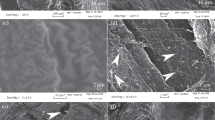Summary
The influence of indomethacin on the biomechanical and biochemical properties of tendons during their healing was investigated. In 68 New Zealand White rabbits a transverse tenotomy followed by repair with a criss-cross suture was performed in the plantaris longus tendon of the left hind limb. The leg was immobilized for 4 weeks postoperatively in a long-leg plastic splint. Half of the animals were treated with indomethacin, 10 mg/kg/day orally, and the other half with placebo. After 4, 8, and 16 weeks of treatment the animals were killed and biomechanical and biochemical parameters were measured. After 16 weeks there was a significant increase in tensile strength in the indomethacin group. There were only small biochemical differences between the groups. However, there was a slight but significant decrease in the amount of soluble collagen in the Indomethacin group. This may indicate a higher degree of cross-linkage following indomethacin treatment, which might explain the increased tensile strength.
Zusammenfassung
Es wurde die Wirkung von Indomethacin auf die biomechanischen und biochemischen Eigenschaften von Sehnen während der Heilung untersucht. Achtundsechzig New Zealand White Kaninchen bekamen eine quere Tenotomie an der Sehne des M. plantaris longus am linken Hinterbein. Die Tenotomie wurde dann mit einer „crisscross” Naht repariert, und das Bein in einem die ganze Extremität umfassenden Verband aus Hexalite vier Wochen lang ruhiggestellt. Die Hälfte der Versuchstiere wurde mit Indomethacin per os in der Dosis von 10 mg/kg/die behandelt, und die andere Hälfte bekam Placebo. Nach 4, 8 und 16 Wochen wurden die Tiere geopfert, und die Sehne auf ihre biomechanischen und biochemischen Eigenschaften untersucht. Nach 16 Wochen fanden wir einen signifikanten Anstieg der Zugfestigkeit nach Indomethacin-Behandlung. Nur geringe biochemische Unterschiede zwischen beiden Gruppen wurden gefunden. In der Indomethacin-Gruppe registrierten wir eine kleine, jedoch signifikante Abnahme in dem Gehalt an löslichem Kollagen. Dieser Fund spricht für einen höheren Grad von „cross-links” nach Indomethacin-Behandlung, was die Zunahme der Zugfestigkeit erklären könnte.
Similar content being viewed by others
References
Butler DL, Grood ES, Noyes FR (1978) Biomechanics of ligaments and tendons. Exerc Sport Sci Rev 6:125–181
Carlstedt CA, Skagervall R (1986) A model for computeraided analysis of biomechanical properties of the plantaris longus tendon in the rabbit. J Biomech 19:251–256
Kulonen E, Potila M (1975) Effect of the administration of antirheumatic drugs on experimental granuloma in rat. Biochem Pharmacol 24:219–225
McIntosh JEA, McIntosh RP (1980) Mathematical modelling and computers in endocrinology. In: Gross F, Grumbach MM, Labhart A (eds) Monographs on endocrinology, vol. 16. Springer, Berlin Heidelberg New York
Parnham MJ, Shoshan S, Schoenmaker H, Bonta IL (1982) Collagen metabolism and phenotype after prostaglandin EZ treatment of granuloma: direct and macrophagemodulated effects. Prostaglandins 23:85–99
Piez KA (1968) Cross-linking of collagen and elastin. Ann Rev Biochem 37:547–570
Raisz LG, Koolemans-Beynen AR (1974) Inhibition of bone collagen synthesis by prostaglandin E2 in organ culture. Prostaglandins 8:377–385
Rø J, Langeland N, Sander J (1978) Effect of indomethacin on collagen metabolism of rat fracture callus in vitro. Acta Orthop Scand 49:323–328
Rø J, Sudmann E, Marton PF (1976) Effect of indomethacin on fracture healing in rats. Acta Orthop Scand 47:588–599
Samuelsson B (1974) Endogenous synthesis of prostaglandins in guinea pigs and man: effects of inhibitors. In: Robinson HJ, Vane JR (eds) Prostaglandin synthetase inhibitors. Raven Press, New York, pp 99–106
Stegemann H, Stalder KH (1967) Determination of hydroxyproline. Clin Chem Acta 18:267–273
Sudmann E (1975) Effect of indomethacin on bone remodelling in rabbit ear chambers. Acta Orthop Scand [Suppl] 160:91–115
Sudmann E, Bang G (1979) Indomethacin-induced inhibition of haversian remodelling in rabbits. Acta Orthop Scand 50:621–627
Sudmann E, Dregelid E, Bessesen A, Møland J (1979) Inhibition of fracture healing by indomethacin in rats. Eur J Clin Invest 9:333–339
Törnkvist H, Lindholm TS, Netz P, Strömberg L, Lindholm TC (1984) Effect of ibuprofen and indomethacin on bone metabolism reflected in bone strength. Clin Orthop 187:255–259
Viidik A (1968) Elasticity and tensile strength of the anterior cruciate ligament in rabbits as influenced by training. Acta Physiol Scand 74:372–380
Viidik A, Danielsen CC, Oxlund H (1982) On fundamental and phenomenological models, structure and mechanical properties of collagen, elastin and glycosaminoglycan complexes. Biorheology 19:437–451
Vogel HC (1977) Mechanical and chemical properties of various connective tissue organs in rats as influenced by non-steroidal antirheumatic drugs. Connect Tissue Res 5:91–95
Vogel HC (1978) Influence of maturation and age on mechanical and biochemical parameters of connective tissue of various organs in the rat. Connect Tissue Res 6:161–166
Winter CA (1965) Anti-inflammatory testing methods: comparative evluation of indomethacin and other agents. International Congress Series, vol. 82. Excerpta Medica, Amsterdam, pp 190–202
Author information
Authors and Affiliations
Rights and permissions
About this article
Cite this article
Carlstedt, C.A., Madsén, K. & Wredmark, T. The influence of indomethacin on tendon healing. Arch. Orth. Traum. Surg. 105, 332–336 (1986). https://doi.org/10.1007/BF00449937
Issue Date:
DOI: https://doi.org/10.1007/BF00449937




